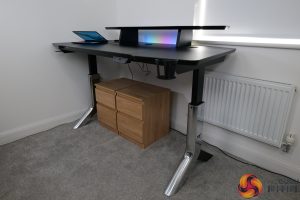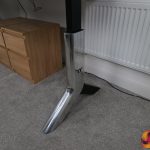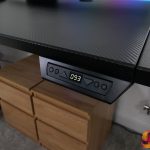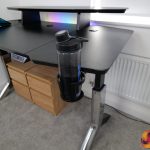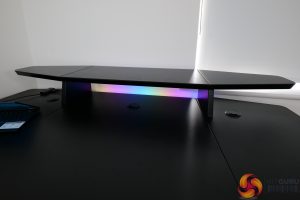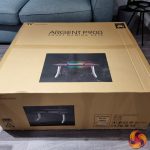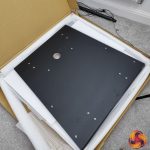What on Earth is this?! Yes, we are reviewing a smart gaming desk that comes in at $2199.99 USD. Yes – that's right; Thermaltake's Argent P900 will bust a hole of more than two-grand in your credit card!
Are the features worth it though? Maybe you will value the 70-100 cm mechanised height range. Or perhaps 150 kg of load capacity is appealing. Or perhaps you just want RGB lighting through Thermaltake's software. Let's take a closer look at the desk and its features.
Timestamps
The Thermaltake Argent P900 is a truly bizarre product. Designed in collaboration with Studio F. A. Porsche, this $2199.99 USD desk has some genuinely useful features.
Firstly, there is the ability to change the desktop height in 1cm intervals between 70cm and 100cm. More so, there are four individual height profiles that can be set, as well as upper and lower limits to avoid the desk hitting any obstructions.
Thermaltake’s marketing materials highlight an ‘anti-collision safety sensor’. I did not have success with this. I placed my clenched fist on top of the radiator and reduced the desk level to the point where it was crushing my fist and caused bruising. So, I’ll have to call out Thermaltake’s marketing materials based on my real-world and genuinely relevant test. This incorporates a seriously strong motor.
There’s more to the desk’s smart features than movement and height adjustment. Thermaltake deploys a strip of RGB lighting along the rear-centre edge. This can be controlled via the supported software tools and can be synchronised with other Thermaltake components.
Speaking of software, we had mixed results on this front. The reason that our editorial piece is going live a handful of weeks after this desk’s launch is due to some issues with the desk – many of which included software.
To be clear, the Windows app seems to work OK. The desk shows up with its lighting profile, and the height adjustment functionality works. For us, though, the Android app simply does not work due to refusing to connect with the control box. And that’s a real shame given that the app holds more functionality and usage data than the Windows tool.
Some of the other issues that we worked on with Thermaltake related to the actual functionality. Initially, we could not get the desk to change its height with RGB lighting connected. Thermaltake suggested that we needed to reconnect the wires, because the manual was unclear. But we already had the wires connected correctly.
Almost by random, the desk started to successfully function alongside RGB after two disconnection and reconnection attempts. This is slightly concerning given that there was no clear reason for the fix.
The other key issue was ‘buildability'. The overall process of putting this desk together was very unpleasant. In fact, I think most people in the position to drop more than two-grand on a desk will simply refuse to spend over four hours of their time putting it together with awkward phases and atrocious instructions.
The guidance via the manual was bad – really bad! Thermaltake has assured us that the Chinese guidance mixed in with English will be removed. But how on earth did this not get presented as an issue during initial internal feedback sessions? The actual guidance itself is poor, too – there’s little clarity and the images are largely ambiguous diagrams.
Plus, the included Allen key is a bargain basement unit that doesn’t really fit properly for the assembly procedure. Cheaping out a few cents on a $2199.99 product is silly. I found the mixed and vague fasteners difficult to work with, too.
There is clearly some genuinely good functionality for the Thermaltake Argent P900 Smart Gaming desk. Its height control works well. The ability to take 150kg load is very good. And small touches such as the headphone hook and cup holder are positive.
I can see how some people may appreciate the design, too. I’m personally not a fan of the non-rectangular angles, but some people may be. The 2.5cm MDF surface feels solid, though I do question the application of MDF on such an expensive product. And that secondary surface adds valuable real estate, even if the wings are limited to 5kg of load each.
Where the Argent P900 really struggles, though, is on the software side of the equation. This gave us headaches that Thermaltake are aiming to address after our extensive feedback, so we can only hope that updates will solve some issues.
Other than that, the ‘buildability' of this 80+kg behemoth was unpleasant, but the finished product is good. And that lifting capacity is impressive.
Should anybody actually buy the Thermaltake Argent P900 Smart Gaming desk? Well, I cannot personally relate to the type of person who has $2199.99 USD to spend on a desk such as this, so I really must refrain from commenting. I guess my overarching feeling is why does a product such as this – and at such an expense – exist? If you’re the type of person who can indeed drop really good gaming rig-type money on a desk that will take half-a-day for you to assemble, then please do let me know the answer to that previous question.
KitGuru says: It’s heavy, it’s cumbersome to build, and the quality touches are often questionable. There is, however, something cool about loading 150kg onto a desk and then having it climb up to 100 cm without breaking a sweat. That’s cool, even if the unit does cost a mind-blowing $2199.99 USD.
 KitGuru KitGuru.net – Tech News | Hardware News | Hardware Reviews | IOS | Mobile | Gaming | Graphics Cards
KitGuru KitGuru.net – Tech News | Hardware News | Hardware Reviews | IOS | Mobile | Gaming | Graphics Cards


